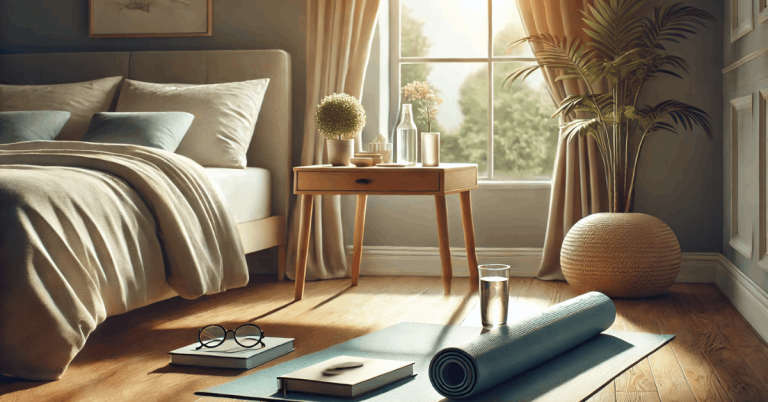Getting fit at home is easier than ever with the right approach and tools. This article focuses on 10 minimal equipment workouts for beginners designed to help you build strength, improve fitness, and stay consistent.
These exercises require only a few basic items, making them accessible and affordable for anyone starting their fitness journey. You’ll find simple, effective workouts to kickstart your routine and achieve results from the comfort of your home.
Stay Consistent for Better Results
Consistency is the key to seeing progress in any fitness journey. Regular workouts help build strength, endurance, and confidence over time. Use these tips to stay on track and reach your goals:
- Stick to a regular schedule to build a lasting habit.
- Set realistic and specific goals that are easy to measure and track.
- Plan your week and choose time slots that fit your routine.
Must-Have Equipment for Home Workouts
A few essential tools can transform your home workouts and keep them effective. These items are affordable, easy to store, and versatile for various exercises:
- Resistance bands for strength and flexibility training.
- Dumbbells or kettlebells to add weight and challenge your muscles.
- Yoga mat for comfort and stability during floor exercises.
- Stability ball for core-strengthening moves.
- Jump rope to boost your cardio routine.
Warm-Up and Stretching Made Simple
A proper warm-up prepares your body for exercise and reduces the risk of injury. It improves blood flow, flexibility, and readiness for movement. Use these steps to ensure your body is ready:
- Start with light cardio movements like jogging in place or jumping jacks to get your heart rate up.
- Include dynamic stretches such as arm circles, leg swings, and hip rotations to loosen your joints.
- Follow a short routine: spend 5–10 minutes combining cardio and stretches to feel prepared and energized.
Workout 1: Bodyweight Squats Explained
Follow these steps to perform them correctly:
- Stand tall with your feet shoulder-width apart and toes slightly pointed out.
- Keep your chest up and lower your body as if sitting into a chair.
- Ensure your knees stay aligned with your toes, and don’t go past them.
- Push through your heels to return to standing, keeping your back straight.
Workout 2: Push-Ups
Beginners can modify the exercise to make it easier while still getting results. Follow these steps to get started:
- Start in a plank position, keeping your hands slightly wider than shoulder-width apart.
- Lower your body by bending your elbows until your chest is close to the floor.
- Push back up while keeping your body straight.
- Modify with knee push-ups or wall push-ups if standard push-ups are too challenging.
Workout 3: Lunges
Lunges are effective for strengthening your legs and glutes and improving balance. Follow these steps to do them correctly:
- Step forward with one leg, keeping your upper body straight and your core tight.
- Lower your body until both knees form a 90-degree angle, with your front knee above your ankle.
- Push through your front heel to return to the starting position.
- Repeat on the other leg, alternating sides for a balanced workout.
Workout 4: Plank
The plank is a simple exercise for strengthening your core and stability. It requires proper form to be effective and safe. Follow these tips:
- Start in a push-up position, keeping your elbows directly under your shoulders.
- Keep your body straight, avoiding sagging or lifting your hips.
- For beginners, try a knee plank to build endurance gradually.
Workout 5: Resistance Band Rows
Resistance band rows strengthen your upper back and shoulders, improving posture and balance. This exercise is easy to do at home with a resistance band.
- Secure the band at a sturdy anchor point and hold the handles firmly.
- Sit or stand, keeping your back straight, and pull the band toward your body.
- Focus on squeezing your shoulder blades together as you pull.
Workout 6: Glute Bridges
Glute bridges target your glutes and lower back, improving strength and stability. They are simple and effective for all fitness levels.
- Lie on your back with your knees bent and feet flat on the floor.
- Lift your hips toward the ceiling, squeezing your glutes.
- Lower slowly and keep your movements controlled for proper form.
Workout 7: Jump Rope
Jump rope is excellent for improving cardiovascular health and coordination. It’s adaptable for beginners looking for a low-impact option.
- Use a lightweight rope to practice timing and rhythm.
- Start with small, consistent jumps to avoid strain.
- For less impact, try slow-stepping movements instead of complete jumps.
Workout 8: Bicycle Crunches
Bicycle crunches strengthen your abs and obliques, promoting core stability. Proper form is key to avoiding strain.
- Lie on your back, hands behind your head, and lift your legs off the ground.
- Bring your opposite elbow toward your knee while extending the other leg.
- Keep your movements slow and controlled for maximum benefit.
Workout 9: Dumbbell Deadlifts
Dumbbell deadlifts target your hamstrings, glutes, and back, improving strength and posture. Focus on proper form to avoid injury.
- Stand with your feet hip-width apart, holding a dumbbell in each hand.
- Bend at your hips, keeping your back straight, and lower the weights toward your feet.
- Return to standing by squeezing your glutes and straightening your body.
Workout 10: Mountain Climbers
Mountain climbers are a full-body workout that improves strength and endurance. They engage your core, arms, and legs with dynamic movement.
- Start in a plank position, keeping your body straight.
- Alternate bringing one knee toward your chest while keeping your core tight.
- For beginners, slow the movement or step forward instead of running in place.
Cool-Down and Recovery Tips
Cooling down helps your body return to rest and reduces muscle stiffness. A few simple steps after a workout can improve flexibility and prevent injuries.
- Focus on light movements like walking to lower your heart rate gradually.
- Include stretching exercises for major muscle groups to increase flexibility.
- Practice proper recovery techniques like staying hydrated and resting sore muscles to avoid strain.
Wrapping Up Your Home Fitness Journey
Getting started with 10 minimal equipment workouts for beginners is a simple way to improve strength and overall fitness from home. These exercises focus on building a strong foundation with minimal tools and maximum results.
Staying consistent, maintaining proper form, and including warm-ups and cool-downs are key to progress. With these tips, you can create an effective routine that fits your lifestyle and keeps you motivated.


